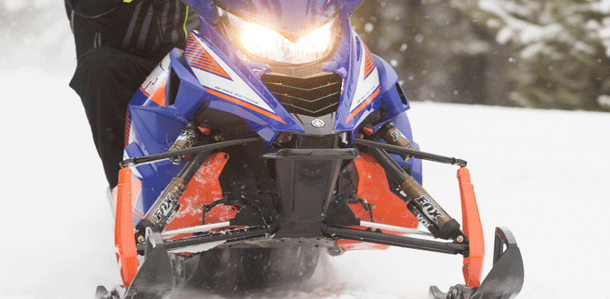
A few members of the snowmobile media recently spent a few days at Yamaha’s snowmobile headquarters to learn about technology used in its snowmobiles. This was an interesting event where editors learned about Yamaha’s fuel injection system, lubricants and some new snowmobile accessories that will debut this fall.
The 172,000-square foot facility in Pleasant Prairie, Wisconsin, not only houses the Yamaha snowmobile marketing staff, technical service personnel and a huge-but-insanely well-organized parts warehouse, but it’s also the home of Yamaha University where dealerships send their mechanics to learn about Yamaha snowmobile diagnosis and repair. Here are some highlights of what Snow Goer learned during the Yamaha Editorial Workshop:
Yamaha Gauge Diagnostics
There are at least 14 sensors and electric components that can be diagnosed with the gauge on fuel injected Yamaha snowmobiles. If, for example, an engine won’t rev more than 3000 rpm, mechanics can retrieve a code displayed on the gauge that indicates a problem with the throttle position sensor and use that to correctly diagnose and replace the failed part. This program can also be used to make sure values like voltage or air temperature are within specification. Diagnostic programs from other manufacturers often require connecting a notebook computer that has special software, but with Yamaha’s system the diagnostic tools are built in.

Yamaha Valve Train Could Be Art
The 12-valve engine that powers Yamaha FX Nytro snowmobiles is a work of art. Our 2-day Yamaha editorial workshop included a valve inspection of the 135 hp engine in Yamha FX Nytro snowmobiles, and once the valve cover was pulled off, we were in impressed with how carefully machined and manufactured components of the valve train appear to be — it truly is a work of art. Yamaha says to inspect valve clearances on the FX Nytro engine every 25,000 miles.
Strict Oil Standards
It takes three to four years for an oil formula to be approved and receive the “Yamalube” name on the container. While other lubricant manufacturers might alter their products’ formulas to respond to outside factors like rising cost or reduced availability of a base oil stock, formulas at Yamalube never change, said Steve Friedrich, assistant department manager for Yamalube. Interestingly, Yamaha engine engineers also help develop oil for their engines.
Dirty Oil Is Good Oil
If oil drained from an engine is only slightly darker in color than when it was poured into the engine, that indicates it might be a cheap lubricant. Used oil should be dark in color because it has grabbed onto the carbon and other gunk that would otherwise be stuck on bearings, piston rings, valves and other parts, in most cases. If oil doesn’t have a good detergent package it won’t remove this stuff from the engine, and that speeds up engine wear, but at least the buyer probably saved $1 per quart ….

Bolts With Grease Zerks
Did you know that some bolts on the front suspension of some Yamaha snowmobiles have grease zerks? This helps keep the bolt rotating freely so it doesn’t stick and cause the suspension to bind. Grease comes out of the pinhole on the bolt shank so it and the bushing won’t corrode and fuse together. The bolt shown here is used to mount the lower A-arm to the bulkhead of a Yamaha Apex.





need support help; 2005 yamaha rage snowmobile replace the timing chain tensioner and having trouble setting the cam timing, according to the manual the intake cam should be at the 5 o’clock position and the exhaust cam at the 7 o’clock position with the timing mark on mag (ll), – intake cam >exhaust cam sprockets when i set it up like i can only turn it 1/4 turn then number 3 cylinder stops on the intake valve, when i set the cam sprocket the same but with the lobe on intake pointing at about 3 0’clock and the exhaust to about 9 o’clock it rolls over just fine.
i my yamaha manual wrong?